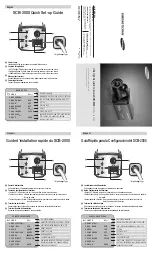
40
(i) Open the doors and windows to ventilate the area (if it is safe to do so).
(ii) Turn off all fuel appliances where possible.
(iii) Evacuate the property leaving the doors and windows open.
(iv) Get medical help immediately for anyone suffering the effects of Carbon Monoxide poisoning
(headache, nausea), and advise that Carbon Monoxide poisoning is suspected.
(v) Ring your gas or other fuel supplier on their emergency number. Keep the number in a prominent
place.
(vi) Do not re-enter the property until the alarm has stopped. (If the Alarm has been silenced by
pressing the Test/Hush button, wait at least 5 minutes. The Alarm will then check that the CO
has cleared).
(vii) Do not use the fuel appliances again until they have been checked by an expert. In the case of
gas appliances this must be a Registered Gas Installer.
The alarm will stop once the CO has cleared.
Pressing the Test/Hush button will silence the alarm immediately for 4min if <150ppm CO. If CO is
still present after 4min, the red LED indicator and horn will turn on again.
Note: When ventilation is provided by leaving the window and doors open, the CO build up may
have dissipated by the time help arrives and the Alarm may have stopped sounding. Although your
problem may appear temporarily solved, it is crucial that the source of the CO is determined and
appropriate repairs made.
NEVER IGNORE THE ALARM!
Summary of Contents for Ei3018
Page 4: ...4 1 Introduction Installer Guide...
Page 10: ...10 2 Installation...
Page 24: ...24 3 What is Carbon Monoxide User Guide...
Page 32: ...32 4 Testing...
Page 37: ...37 5 What to do in case of FIRE...
Page 39: ...39 6 What to do in case your Alarm detects Carbon Monoxide...
Page 41: ...41 7 Troubleshooting and Indicator summary tables...
Page 51: ...51 8 Important Safeguards...
Page 54: ...54 9 Service and Guarantee...
Page 57: ...57 KM86596 KM83678 EN50291 1 2010 A1 2012 BS5446 2 2003...
Page 58: ...58...
Page 59: ...59...
















































